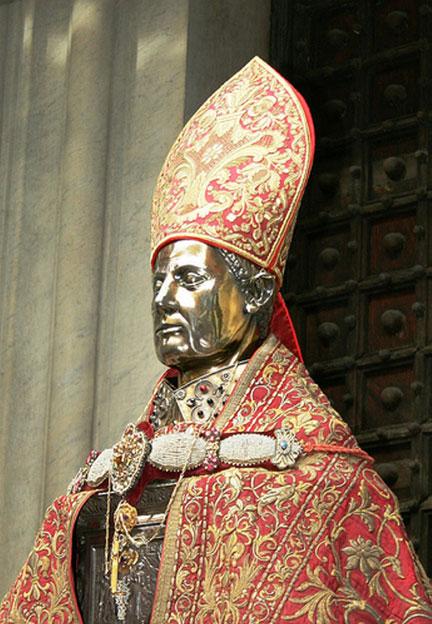San Gennaro is a martyr saint of the Roman Catholic and the Eastern Orthodox Churches and the patron saint of Naples, honoured every year on the 19th of September when his blood is believed to liquefy. Vials containing blood of San Gennaro and his bust are traditionally carried through Naples and exhibited during a procession.
Epidemics and earthquakes are believed to have been tamed by San Gennaro and so the cult of the saint and the belief in his power to protect Naples from Mount Vesuvius is a most indestructible one.
This cult prompted many kings, queens, emperors and popes to bestow lavish gifts in honor of San Gennaro through the centuries, commissioning the highest acclaimed goldsmiths and silversmiths in Naples to create jewels, statues and religious items. This famous "treasure" was even the protagonist of a 1960s movie titled "Treasure of San Gennaro" (Italian: "Operazione San Gennaro"), an Italian comedy directed by Dino Risi starring Nino Manfredi and Totò, telling the story of a perfect robbery plan of the treasure, which is believed to be worth more than Britain's Crown Jewels, and is now on display in Rome for the first time.
Over centuries a select committee of trustees, appointed to guard the special jewels, have kept them safe in a vault in the cathedral under lock and 'golden' key at the Royal Chapel of The Treasure of San Gennaro in Naples. The collection is now kept at the Museum of The Treasure of San Gennaro. The museum’s director, Paolo Jorio, proudly explains that it virtually tells the history of Europe.
For the first time, the jewels are now on show outside of Naples at Palazzo Sciarra, in Rome, until the 16th of February 2014. Emmanuele Emanuele, head of the Rome Foundation organizing the exhibition, has said the collection is historically and artistically priceless, one of the most important collections of religious art in the world.
Entering the first room of this exhibit, the spotlight is on a grand golden carriage, while a rainbow array of stunning gems adorn the walls in honor of this third-century martyr. Gigantic, awe-inspiring candelabras decorated with cherubs, along with a reliquary bust of San Gennaro in gold and silver containing his skull, are showcased alongside the necklace of San Gennaro. Made to adorn the bust, this absolutely stunning example of workmanship is thought to be not only the masterpiece of this collection, but also one of the most precious pieces of jewellery in the world.
Goldsmith Michele Dato started working on it in 1679. It is made with emeralds from Colombia, sapphires and hundreds of diamonds; the design is mind-blowing. You think you've seen jewels until you've seen this, which includes a cross of emeralds and diamonds donated by French Emperor Napoleon Bonaparte. Separate pieces of jewellery have been forged together over centuries to create this necklace, made up of gifts, with many from monarchs.
The Bishop’s Mitre, used for religious processions of the bust, is again dazzling and ornate, made of gold-plated silver and adorned with over 3000 diamonds, huge square-cut emeralds, and hundreds of other rubies and emeralds. We can only imagine how spectacular a procession must be in all its glory. Importantly, the empty vial claimed to contain the coagulated blood of the Saint, which turns to liquid during such ceremonies, is believed to be a miracle that by legend brings good fortune to the city, and thousands of people gather in Naples three times a year to see whether the blood changes.
Lapis lazuli, malachite, silver and gold; chalices and tapestries in silk threads; statues and the sheer geology of what's in front of you truly leave you in awe, and you cannot help but notice you are not the only one saying 'wow', as a statue of Archangel St, Michael stands above a slayed dragon, tongue lolling on the ground.
Naples has long been famed for its gold smithery, which has ancient roots since the Greek colonial period and the Roman Empire. In the 16th century, the monarch issued laws and decrees regulating goldsmiths and silversmiths. The guild of goldsmiths, a noble art, was one of the first craftsmanship to be associated with Naples and it was as early as 1305 that the King of Naples, Charles 3rd of Anjou, commissioned the first gift for San Gennaro and started the visible legacy of faith and art combined. Considering that in the 16th Century there were as many as 300 workshops in Naples, one instantly gains an appreciation of these individual artisans and the sheer talent available at the time with the designs being literally breathtaking. It is also thanks to this artistry and these creations that Il Tesoro di San Gennaro exists, along with the cult of the saint, making it even more exceptional.
Therefore, during the exhibition, the Fondazione Roma-Arte-Musei have organised a series of conferences and educational activities for schools and families in order to engage the public in the ancient art of goldsmiths.











